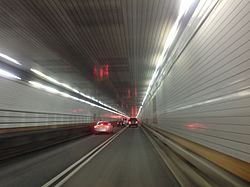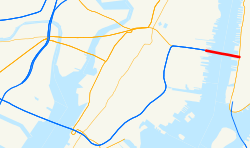Holland Tunnel facts for kids
 |
|
| Eastbound in the Holland Tunnel in December 2019 | |
| Overview | |
|---|---|
| Location | Jersey City, New Jersey–Lower Manhattan, New York City |
| Route | |
| Operation | |
| Operator | Port Authority of New York and New Jersey |
| Toll | (Eastbound only) As of August 29, 2019:
|
| Vehicles per day | 89,792 (2016) |
| Technical | |
| Length | 8,558 feet (2,608.5 m) (westbound) 8,371 feet (2,551.5 m) (eastbound) |
| Number of lanes | 4 |
| Tunnel clearance | 12.6 feet (3.84 m) |
| Width | 20 feet (6.1 m) |
| Route map | |
The Holland Tunnel is a special road that goes under the Hudson River. It connects Jersey City, New Jersey on the west side to Lower Manhattan in New York City on the east side. This tunnel is managed by the Port Authority of New York and New Jersey. It is part of Interstate 78 and New Jersey Route 139.
The Holland Tunnel is one of three main ways for cars to cross between Manhattan and New Jersey. The other two are the Lincoln Tunnel and the George Washington Bridge.
People first thought about building a road crossing under the Hudson River in 1906. But it took a long time to agree on the plans. Finally, in 1919, they decided to build a tunnel. Construction started in 1920 and the tunnel opened in 1927. When it opened, it was the longest underwater tunnel for cars in the world.
The Holland Tunnel was also the first tunnel in the world to have a special system to bring in fresh air. This system was designed by Ole Singstad. The tunnel was named after Clifford Milburn Holland, who was the first chief engineer for the project. Sadly, he passed away in 1924 before the tunnel was finished.
Contents
About the Holland Tunnel
The Holland Tunnel is named after Clifford Milburn Holland, who was the main engineer. He died before the tunnel was completed in 1927. Another engineer, Ole Singstad, took over and finished the project.
The tunnel was the first in the world to have a mechanical ventilation system. This system uses 84 large fans in four buildings. These fans push fresh air into the tunnel and pull out dirty air. They can completely change the air inside the tunnel every 90 seconds. This is very important because car exhaust used to have a lot of poisonous carbon monoxide. The ventilation system keeps the air safe for drivers.
The tunnel has two separate tubes. Each tube has two lanes for cars. The road in each tube is about 20 feet (6 meters) wide. The ceiling is about 12.5 feet (3.8 meters) high. The north tube is a bit longer than the south tube. Both tubes are built deep under the river. The lowest part of the road is about 93 feet (28 meters) below the water's surface.
Many vehicles use the Holland Tunnel every year. In 2007, about 34.7 million vehicles passed through it. The tunnel is owned and operated by the Port Authority of New York and New Jersey.
The Holland Tunnel is considered a very important historical site. It was named a National Historic Civil and Mechanical Engineering Landmark in 1982. It also became a National Historic Landmark in 1993.
Tunnel Entrances and Exits
The entrance to the Holland Tunnel in Jersey City is near where New Jersey Route 139 and Interstate 78 meet. This area is called Boyle Plaza. It was named after John F. Boyle in 1936. This part of the road is unique because it has stoplights.
On the New Jersey side, there is a nine-lane area where tolls are collected. This area uses E-ZPass, which was first available in 1997.
In Manhattan, after exiting the eastbound tube, cars enter a circular road called the Holland Tunnel Rotary. This was built after a freight building was taken down. In 2004, the rotary was updated to have a fifth exit.
There are also small public spaces called Freeman Plaza West, East, and North. These areas used to be toll plazas. In 2013, Freeman Plaza West was opened to the public. It has tables, chairs, and trees. It's named after Milton Freeman, another engineer who worked on the tunnel. Later, Freeman Plaza East and North also opened. They even have solar-powered charging stations.
Building the Tunnel
For hundreds of years, people could only cross the lower Hudson River by boat. Then, in the early 1900s, tunnels were built for trains. These included the PATH train tunnels and the Pennsylvania Railroad tunnels. Once engineers saw that tunnels could be built under the river, people wanted a tunnel for cars too.
In 1906, New York and New Jersey started planning a crossing. They first thought about building a bridge. But in 1913, they decided a tunnel would be better. A bridge would need to be very high (about 200 feet or 60 meters) to let ships pass. This would make the land needed for the bridge entrances too expensive.
Several designs were considered for the new tunnel. The final design, proposed by engineer Clifford Milburn Holland, involved two separate tubes. Each tube would have two lanes of traffic going in the same direction. Holland was chosen as the chief engineer for the project.
Construction of the "Hudson River Vehicular Tunnel Project" began on March 31, 1922. Workers started digging from Canal Street in New York City. On October 27, 1924, just before the two halves of the tunnel were supposed to connect, Clifford Holland passed away from a heart attack. Many believed it was due to the stress of the project. A ceremony where President Calvin Coolidge would have connected the tunnel remotely was canceled.
The project was renamed the Holland Tunnel on November 12, 1924, in memory of Clifford Holland. After Holland, Milton Harvey Freeman took over, but he also passed away in 1925. Finally, Ole Singstad became the chief engineer. He finished the tunnel and designed its amazing ventilation system.
Construction Challenges
Building the tunnel was very difficult. Workers, called "sandhogs," had to work in special chambers called caissons. These chambers had high air pressure to stop river water from coming in. Workers entered through airlocks and could only stay inside for a limited time. When they left, they had to slowly adjust to normal air pressure to avoid a painful condition called "the bends." Luckily, no workers died from the bends.
The entire tunnel project took almost seven years to complete. Sadly, 14 workers lost their lives during the construction.
Designing the Air System
The most important part of the Holland Tunnel's design is its special air system. Before this tunnel, no long road tunnels had been built because it was hard to get rid of all the car exhaust.
There are four ventilation towers for the two tunnel tubes. These were designed by architect Erling Owre.
Some people, like Thomas Edison, thought it would be impossible to properly ventilate a tunnel as busy as the Holland Tunnel. But engineer Ole Singstad came up with a new way to do it.
Singstad worked with Yale University and the United States Bureau of Mines. They built a test tunnel over 400 feet (120 meters) long. They put cars inside with their engines running. Students volunteered to breathe the exhaust to test how much fresh air was needed. Singstad found that a normal air system would not work.
He then designed a system where the tunnel would have three levels. The middle level would be for cars. The levels above and below would be for air. The bottom level would bring in fresh air, and the top level would take out dirty air. This solved the ventilation problem.
When the tunnel opened, the air inside was very clean. People said the air in the tunnel was even better than on some streets in New York City!
Tunnel Operations
The Holland Tunnel officially opened at 4:55 PM on November 13, 1927. President Coolidge opened it from his yacht using a special key. The widows of Chief Engineers Holland and Freeman were among the first people to drive through.
The tunnel was an instant success. On its first day, over 51,000 vehicles used it. The toll for a car was 50 cents. This money helped pay for the tunnel's $48 million cost. In 1930, the Port Authority of New York and New Jersey took over running the tunnel.
Horses and pedestrians have never been allowed in the tunnel. In 1955, a small electric car was made for police officers to patrol the tunnel from the side walkways.
Modern Updates
From 2003 to 2006, the fire safety system in both tunnels was updated.
In October 2012, the Holland Tunnel had to close because of Hurricane Sandy. The storm caused the tunnel to flood. It reopened for buses a few days later and for all traffic on November 7.
Safety and Security
In 1949, a fire started in the south tube of the tunnel when a chemical truck caught fire. This caused a lot of damage and injured 69 people. Sadly, two first responders, a fire chief and a Port Authority officer, died from their injuries. After this, the Port Authority made strict rules about carrying dangerous materials in the tunnel.
The Holland Tunnel is considered a very important target for security. Because of this, there are strict rules for vehicles.
After the September 11 attacks in 2001, the tunnel was closed for over a month. When it reopened, new rules were put in place. For a while, cars with only one person and certain types of trucks were not allowed during busy weekday mornings. Now, most trucks are allowed, but very large trucks and vehicles pulling trailers are still banned.
Cell phone service was briefly turned off in 2005 after some events in London, but it was turned back on a few days later.
In 2006, there was a plot to detonate explosives in the PATH train tunnels, which was at first mistakenly reported as a plot against the Holland Tunnel.
Paying to Use the Tunnel
As of 2024, if you drive from New Jersey to New York City, you pay a toll. There is no toll if you drive from New York City to New Jersey. For cars, the toll is $17.63 if you pay by mail. If you use an E-ZPass from New Jersey or New York, it's cheaper. During off-peak hours, it's $13.38 for cars. During busy hours, it's $15.38.
Tolls are collected on the New Jersey side of the tunnel. Before 1970, tolls were collected in both directions. But then, they stopped collecting tolls for westbound drivers and doubled the toll for eastbound drivers. E-ZPass was introduced in 1997.
In March 2020, because of the COVID-19 pandemic, all tolls became electronic. This means you can no longer pay with cash. Cameras take a picture of your license plate if you don't have E-ZPass, and a bill is mailed to you. If you have E-ZPass, sensors read your transponder.
Future Toll Changes
There are plans for something called "congestion pricing" in New York City. This would mean drivers entering Manhattan through the tunnel might pay a second toll. This plan is currently on hold. If it happens, drivers using the Holland Tunnel to enter the special "congestion zone" would get a discount on the congestion charge.
Images for kids
-
Jersey City entrance during rush hour
See also
 In Spanish: Túnel Holland para niños
In Spanish: Túnel Holland para niños





